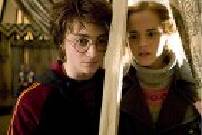|
|
||||
|
|
by Jeffrey Chen  The Harry Potter series didn't really begin for me until the third movie, Prisoner of Azkaban. After seeing Alfonso Cuarón's vision for this series, the first two films, directed by Chris Columbus, feel cute and perfunctory. Cuarón's movie comes across as organic -- dirty and messy like real life. I had hoped he could continue the work with the fourth film, Harry Potter and the Goblet of Fire, but it fell into good hands with Mike Newell. In many ways, Goblet of Fire plays like a direct continuation of Azkaban in both style and themes. Again, it seems dirty and lived-in, but, as Newell is the first actual British director to helm a Harry Potter episode, it's also instilled with a Brit's native sense of roughness. Newell's tougher touches replace even the glancing moments of wonder and awe that Cuarón maintained in his movie. There's little to feel wonder towards this time, as danger, insecurity, and awkwardness loom large and overshadow any magical discoveries. If we take Azkaban to be the real beginning of the series, it's the Star Wars to Goblet's The Empire Strikes Back, in terms of relative size and ambition. Goblet of Fire is easily the most cinematic of J.K. Rowling's books so far. It has a movie-friendly plot about four students -- one of them Harry (Daniel Radcliffe), of course -- competing in a school-sanctioned wizard's tournament. It also steers towards very dark moments with the heretofore largely unseen main villain (a very theatrical Ralph Fiennes) waiting for his close-up, and showcases a great new character played with scene-chomping relish by Brendan Gleeson. The story contains built-in set pieces (each of the three dangerous contests), a build-up to a scary climax, and lots of filler in-between. Poor screenwriter Steve Kloves had to chop away a good deal of fat just to make this film manageable in under three hours. All of the big scenes do their jobs here, but the plot mechanics are actually so big they threaten to obscure the more human aspects of the film. Those precious bits of the teenage experience do come through in many small places (the Weasley twins Fred and George (James and Oliver Phelps) are an especially riotous act this time), but when the action cranks up the two sides feel as if they're competing. Thank goodness Newell treats us to a wonderful bit in the middle of the movie and takes the time to revel in it. The "Yule Ball" sequence emerges as the film's best section, a humorous and touching observation of the torturous teenage ritual of the high school prom experience. It's here where we get to see some fun character interactions and personalities played against each other, as our heroes Harry, Hermione (Emma Watson), and Ron (Rupert Grint) all develop the petty jealousies and insecurities we were all once familiar with (or, for some of the audience, will be familiar with one day -- poor kids). The youths really shine here, and the brink of sexual tensions is explored for the first time. Newell, of Four Weddings and a Funeral fame, shows he still has a touch for this kind of thing, and it makes a strong showing in Goblet. Returning to the plot and the contests (where even the trusty Hermione and Ron are sidelined) is almost a letdown, but the story must go on, and Kloves and Newell do their best to pack it all in there. The result? The biggest, buffest, meanest, and most epic movie of the Harry Potter series yet. It's the one that finally fills the spaces this humongous franchise has carved out for itself. I can't think of any Potter fan who won't find something to attach to in this outsized action fantasy. As for this Potter fan, I'll take the human moments when they reveal themselves, and enjoy the spectacular moments for what they are. (Released by Warner Bros. and rated "PG-13" for sequences of fantasy violence and frightening images.) Review also posted at www.windowtothemovies.com. |
||
|
© 2025 - ReelTalk Movie Reviews Website designed by Dot Pitch Studios, LLC |



